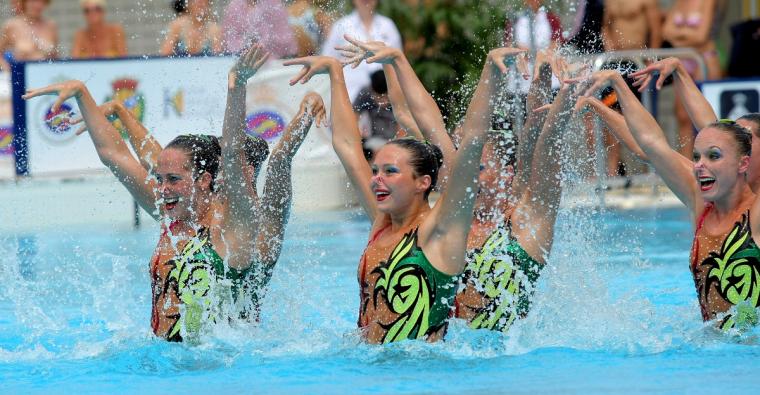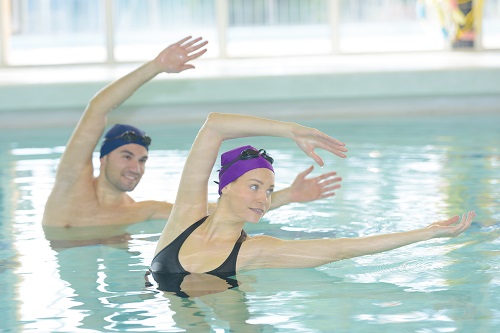
Artistic swimming, long considered the purview of women’s teams, could be getting a refresh in the next Olympics. Photo © MaxiSports | Dreamstime.com
Artistic swimming — the Olympic sport formerly known as synchronized swimming — made a splash in the international aquatics world this month with the announcement that men and women might both compete in the Paris 2024 Summer Games.
As Inside the Games reports:
The International Swimming Federation (FINA) Technical Congress produced “nearly 99 percent of votes in [favor]” of rule changes to artistic swimming between 2022 and 2025, one of which was approval that team routines “shall consist of eight competitors, with up to one reserve, and that the total number of competitors may include a maximum of two male competitors.”
Previously male swimmers have only been able to perform in mixed duets, although in August Italy’s Giorgio Minisini became the first male artistic swimmer to win an individual European Aquatics Championships title with victory in the men’s solo technical final.
Men have competed at the World Aquatics Championships since 2015 accompanied by a woman, but the Olympics have remained elusive. That could change, though, pending confirmation by the International Olympic Committee.
“FINA is committed to gender equality and creating more opportunities for men and women to compete in aquatics sport,” FINA President Husain Al-Musallam told the website. “This rule change reflects that commitment and is part of our vision to maximi[z]e the global appeal of artistic swimming.”

Indeed, the sport “long misunderstood and maligned as a frothy performative spectacle” — as NBCChicago.com put it in 2021 — underwent a name change in 2016 because of FINA’s desire to boost its popularity with a rebrand. And in 2020, USA Synchronized Swimming became USA Artistic Swimming.
“As a world leader in the sport, we recognized the need to align with the changes FINA made, and we are proud to support the great work that is being done by them to move our sport forward,” USA Artistic Swimming Chief Executive Officer Adam Andrasko said at the time. “However, that is not the only reason for the change. The name change offers us an opportunity to showcase how the sport has evolved. Gone are the days of water ballet. This is where true athleticism and artistry meet. We look forward to showing you how exciting artistic swimming is.”
Some artistic swimmers train for up to 10 hours per day, and the sport is considered “one of the most physically grueling specialties at the Olympics.” Goggles are banned, and judges critique artistic swimmers (who wear lots of waterproof makeup) on presentation. That means no squinting or eye-rubbing allowed during their two- to four-minute routines.
“Imagine sprinting all-out, while underwater, chlorine in your eyes, holding your breath and trying to be in line with seven of your other colleagues,” Kim Davis, president of Artistic Swimming Australia, told NBCChicago.com.
“If you think that that is easy, we are doing our job fine,” Minisini, 25, told CNN.com last year. “If you see that we are struggling, … maybe we are missing something.”
A rulebook for the sport of synchronized swimming, written in 1940, stated that “[c]ompetitors may be men or women or both, according to BBC.com. But when the Amateur Athletic Union adopted synchronized swimming in the United States the following year, the sexes were divided to maintain consistency with other sports AAU oversaw.
“It was designed for both sexes, and the AAU wanted it separate,” Bert Hubbard, who competed in synchronized swimming in the early 1950s, told the BBC in 2015. “But this whole idea that the male has so much more advantage in the water — if you’re in the water you find out very quickly that being a man is more of a liability.”
He was referring to the lack of flexibility and decreased buoyancy men have in the water, compared to women. Back in the day, men were allowed to compete against other men, but that proved unpopular “and the competitions died out,” the BBC noted.
Fast-forward to this month: “They always say blue for boys, pink for girls, or dance for girls and judo for boys. No, you can do everything,” Virginie Dedieu, a former three-time French world champion in artistic swimming, told The Japan Times after Minisini’s historic win at the Worlds in August. “It’s an opportunity to say (to little boys) that it’s possible. If you feel like it, go for it.”
“Sometimes I was ashamed to say I was doing it, so I said I was just swimming. I used to hang out with kids who didn’t understand that a boy could do a female sport. But now I’ve come to terms with it,” added Quentin Rakotomalala, who also competed in the Worlds. “[What I liked] was the artistic side, the dancing side. I’ve loved water since I was a kid. All of that mixed together, it was really made for me.”

